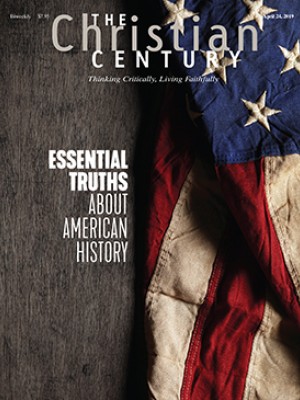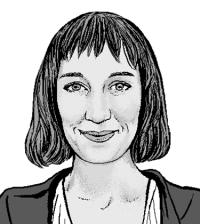The people who haunt us
Jordan Peele’s new horror film reveals the pasts we are all tethered to.

Jordan Peele understands that sometimes being terrified is truly delightful, and sometimes what delights us is truly terrifying. His fantastic new movie Us moves with speed and grace from high suspense to horrifying fright to deadpan humor, never taking the horror genre so seriously it forgets to have fun with it.
But Peele also revels in the genre’s capacity to literalize our worst fears and force us to face our demons by giving them bodies. In his directorial debut Get Out (2017), old rich white people kidnap and auction off young healthy black bodies to inhabit via brain transplants, forcing the consciousness of the black person into a waking sublimation called the “sunken place.” White fear and fetishization of black bodies are the text and subtext of the horror.
Read our latest issue or browse back issues.
In Us race is never mentioned explicitly, although it is an obvious context. Peele is satirizing something more ambitious: the ideals of human personhood that ground our democracy.
As the attractive, affluent Wilson family drives to the California coast for their summer vacation, dad Gabe (Winston Duke) cracks corny jokes and the siblings Zora (Shahadi Wright Joseph) and Jason (Evan Alex) bicker casually. The only sign of tension is in the strained smile of mom Adelaide (Lupita Nyong’o). She is nervous about this particular California beach because of something that happened to her there when she was a child, the first hints of which are given to us in the movie’s opening scene. This event runs like an electric current of terror through the whole movie.
Unease turns to horror when the Wilsons are back home settling in for the night and another family appears in the driveway. They are dressed in red, wielding golden scissors, unable to speak (save for the mother). If that weren’t scary enough, they are the identical but malicious twins of each member of the family. As the shadow family begins to hunt down their doppelgängers, things get really scary.
There are many ways to interpret the Tethered—the film’s word for these doubles. The film opens with a prelude in 1986 at the height of the Hands Across American campaign to end hunger. In that campaign, people stood holding hands across the nation to raise money for antipoverty efforts. The human chain is repeated in the present day of the film, to terrifying effect. While this is a lot for a horror film to pull off, Peele is drawing our attention to the problematic nature of such public performances when they are simultaneously undermined by public policy that criminalizes poverty and guts the social safety net. The divisions of race and class sowed in the Reagan years are coming back in zombie form in the Trump years.
But the shadow people are not zombies, exactly. They are flesh and blood alter-people who live underground, tethered to their aboveground humans, mimicking their actions. The film does not flesh out how this works, metaphysically or scientifically. There’s a suggestion that these doubles are the unexpected fallout of some experiment to fashion a new kind of human. They are the shadow not just of bad public policy or discrete periods of US history but of the very idea of the human person that allowed the American experiment to flourish.
Many scholars have written about how the Enlightenment ideal of the modern person—a free, rational individual who can enter into free democratic relationships of governance and property exchange—didn’t just sit uneasily alongside the practice of racialized slavery and colonialism; it depended on those realities to define itself against. In Toni Morrison’s words, “the concept of freedom did not emerge in a vacuum. Nothing highlighted freedom—if it did not in fact create it—like slavery.” (We might add, to slavery, indigenous massacre and settler colonialism.)
When Adelaide’s double Red tells Adelaide about her experience underground, it is hard not think of the histories of black women denied the value of womanhood and motherhood, their babies ripped from their bodies and arms as property, their pain consistently denied because it is imagined they feel less. Red is not just Adelaide’s id—the repository of an individual psyche’s darkness. She is the body subjected to violence that makes Adelaide’s personhood possible to begin with.
Peele isn’t satisfied presenting this as a problem just for black people. Everyone—regardless of race or class—is haunted by the Tethered. This is what gives the movie its title: in this highly divisive moment of our national history, Peele suggests there is an “us”—a US. The divisions we feel aboveground are a symptom of a deeper kind of shared history—a unity of fear, violence, and forgetfulness. It is a testimony to Peele’s power as a filmmaker that he weaves this overwhelming idea into an absorbing and even enjoyable film. He got the genre right: we should be terrified.
A version of this article appears in the print edition under the title “The people who haunt us.”






